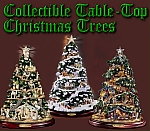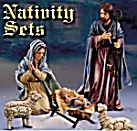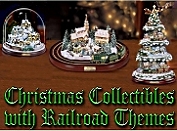


|
Growing Your Hobby with Shrinking Resources
Okay, now may not be the best time to invest $1000 into a single collection or piece of equipment. But that doesn't mean you can't enjoy and build on the hobby investment that you already have.
In my case, my hobbies include garden railroading outside and a certain amount of On30 railroading inside, so I've been accumulating examples for both. If you have something you can add to any train- or town-related hobby, please let us know, and we can make the list as long as you want.
Review and Rethink
- Start a notebook for ideas, then sit down with the books your have or the articles on our sites and simply make a list of things you'd like to try some time. Some of them might involve real money, but some of them might involve simply a change in the way you do or look at things. For example.
- Document the history of your railroad and communities. Write it up. Really. When was the railroad formed, how long ago were the towns founded, what were the key industries then, how have things changed, and so on. You can follow a real-world history or make up your history based on a combination of railroads and/or communities. But once you have this "history," it will help you think more critically about how the various elements of your railroad and communities go together. In the long run it will give you more pleasure and show visitors a much more coherent presentation.
- Consider your communities and their rail needs. Cluster your buildings and accessories into distinct communities, based on apparent scale, period, and region. Then decide what kind of rail service each community needs and plan trains that are specific to those needs. (One article that deals with such ideas is Themes, Conventions, and Willing Suspension of Disbelief)
- Rethink your railroad's operations. Even if you spend 90% of your time running trains in a circle, think about what industries you have and where, and which stations should (theoretically) be served by express trains or by locals. Think about how your industries might serve each other, such as logging camp -> lumber mill -> furniture factory -> warehouse. How does that affect how your trains serve those industries? (Two articles that deal with such topics are Planning Your Garden Railroad for Operations and Introduction to Train and Car Cards.
- If you have at least three industries that your railroad can serve, make some Train and Car Cards for your own railroad.
Find Projects You Can Do for Little or Nothing
Our Family Garden TrainsTM and BIG Indoor TrainsTM primer articles include a number of projects that cost little or nothing. We'll keep an eye out for more, and we'd appreciate it if you let us know when you find or create a project that other folks would be able to do "on the cheap."
 Scrounge items you can use in place of expensive purchases -
We have a whole article on converting non-models to models to use on our railroad, otherwise known as trashbashing. While the Fischer Price buildings I used in that article are now becoming relatively rare, other items take their place. Scrounge items you can use in place of expensive purchases -
We have a whole article on converting non-models to models to use on our railroad, otherwise known as trashbashing. While the Fischer Price buildings I used in that article are now becoming relatively rare, other items take their place.
As an example, a recent trip to the thrift shop netted me a "Mega Blocks" bank store front that can be slightly carved up, repainted and used on my outdoor railroad. The same trip also netted me a very collectible village house from a series that I already own some of. A chimney is broken off, but that's invisible from the front.
Figures that have been separated from play sets, Avon bottle cars (as long as they have the car roofs) - the list of usable, if not optimum, products you can get for a few dollars is pretty long, as long as your imagination is active when you go into the thrift shop, flea market, or garage (tag) sale. In years past, garden railroaders have also found bird feeders and mailboxes that represented buildings and were close enough to scale to use. Keep your eye out - just because it isn't made today doesn't mean it isn't floating out there somewhere.
 
- Add Hobo Signs - Between the 1930s and 1960s, millions of people traveled by "hopping trains" without exactly paying for passage. Most of those folks started out moving from town to town to look for work, although for some, being a hobo became a lifestyle all of its own. Hobos developed a system of marking good and bad places to camp or beg, or even where the jails were clean. The marks themselves varied over time and regions, but there are many good internet sources, including the "Fran's Hobo Sign Page". Choose some signs to use that fit your railroad facilities and communities and paint them in appropriate places with a paint pen. Keep a list of which signs you used on a piece of paper - you can always have kids do a "scavenger hunt" for the signs.
Especially for Indoor Railroads
Especially for Garden Railroads
- Start a plant nursery and or co/op - Start plant starts in a special "nursery" part of your garden. If nothing else, this will give you a place to put otherwise desirable plants from between your rails, or plants you needed to thin for other reasons. Then trade starts with others. Sedums are the easiest plants for this sort of thing, but most groundcovers will also work well, and even some trees that can be seeded or rooted from twigs.
- Build a building out of spare parts and inexpensive materials - Yes we all know that Garden Railroad buildings are supposed to be made of injection-molded styrene. But you can also use materials like those fluted plastic signs that deface well-traveled street corners, or recycled aluminum cans that have been flattened out and crimped to represent corrugated steel sheets. For windows, you can use leftover windows from other kits, or cut-apart fruit or vegetable baskets. In fact, a two-liter bottle provides a lot of glazing, provided you can fasten it down in such a way that it doesn't keep curling.
- Keep your eye open for other ways to build inexpensive buildings. For example,
- Candy molds can provide small pieces of roofing and, in one case, an easy way to mold a "Large Scale" outhouse from anchoring cement or the like.
 Post caps for deck posts can be used as roofs for small buildings. Post caps for deck posts can be used as roofs for small buildings.
Conclusion
This list is just to give you some ideas for keeping your hobby alive and well even if you have to cut back on your new-building or new-railcar addiction until the economy improves. Consolidate, rethink, reuse. In fact, most railroads could use some rethinking every so many years regardless, why not do it now?
Please let us know if you have suggestions for this list. We'll add them if they seem appropriate, and give you full credit.
Best of luck, have a great fall and winter, enjoy your trains, and especially enjoy any time you have with your family this season.
Paul
familygardentrains.com
 Return to the Blog-Like Content Menu Return to the Blog-Like Content Menu
|





|










































